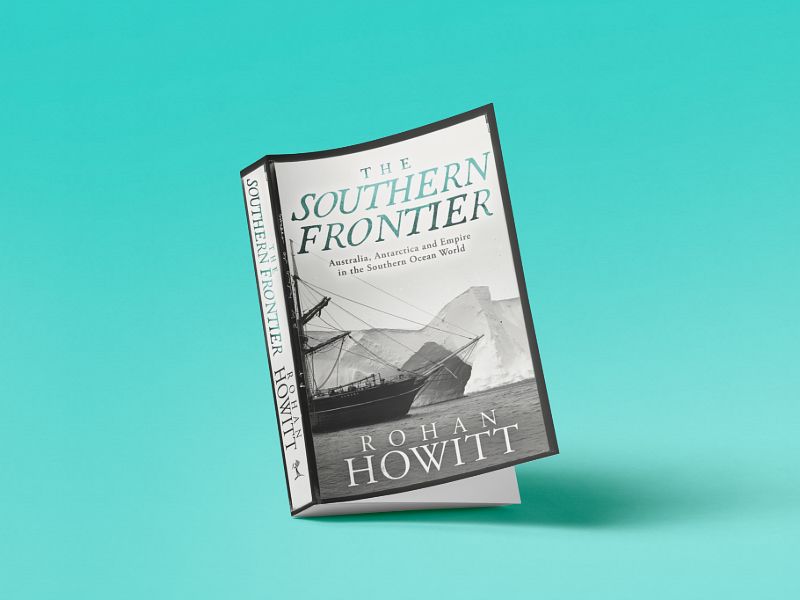Extract: The Southern Frontier by Rohan Howitt
Introduction

Why has Antarctica long loomed large in Australian psyche? How did Australia come to see Antarctica as a natural extension of our territory and why did we so relentlessly pursue the acquisition of our Antarctic Territory?
In The Southern Frontier, Monash University lecturer Rohan Howitt traces the history of Australia’s obsession with Antarctica from the early nineteenth century to the creation of the Australian Antarctic Territory and a permanent national Antarctic program in the 1930s and 40s. Delving deep into Australia’s beliefs, ideas and anxieties about Antarctica, Howitt reminds us of a forgotten way of thinking about this region: as one of a frontier of an Australian Empire stretching from the equator to the South Pole.
In the extract below, Howitt considers how Australia’s southern location has played a crucial role in our history.
How would Australian history look if Antarctica and the Southern Ocean were shifted from the periphery to the centre of the map? I argue that what constitutes ‘Australia’ is radically larger than the familiar, continental map accounts for. A south-oriented cartography must find room for Australia’s Empire, for not one but two continents, for three oceans and four seas, and for a sprawling network of island territories stretching from the Antarctic coastline to just shy of the equator. The reality and the legitimacy of Australian control of particular places within this region—both overseas and within the Australian continent itself—is, of course, contestable, and varied considerably across time and place. To take just one example, the subantarctic Kerguelen archipelago, 4,200 kilometres south-west of Perth, was simply assumed to be under British or Australian control until 1892, when France unexpectedly announced that it had annexed the islands, leading to a spurt of diplomatic efforts to ‘get them back’.i While Australian control could be dubious and contested in certain places at certain times, this perspectival shift reveals that territorial expansionism was a more ambitious, more multidirectional, and altogether more significant project in Australian history than has hitherto been acknowledged. In this south-oriented story, Australia cannot simply be seen as an outpost on the periphery of a British Empire; it must instead be understood as an expansionist polity with aspirations to be the centre of an empire of its own. This imperial aspiration was not limited to the south-western Pacific—the region in which historians have previously discussed the idea of an Australian Empire—but was central to Australian thinking about, and activities in, the lands and seas to the south. A history of Australian ways of thinking about Antarctica and the Southern Ocean is necessarily a history of an Australian Empire.
This book, then, is a history of Australian Empire written from the perspective of its southern frontier. This was, it must be recognised, a decidedly unusual frontier. Elsewhere in Australia, the frontier of European settlement was a zone characterised by dispossession, cultural devastation, violent conflict, massacres and First Nations resistance.ii Antarctica and the Southern Ocean islands, by contrast, had never been permanently settled. Nonetheless, the southern frontier had much in common with its continental counterparts. It was a commodity frontier, a frontier of administration, and even at times a frontier of settlement. Like Australia’s internal frontiers, it was a site of tension between expectations—that new territory could constantly be acquired, transformed and made productive—and environmental realities that constrained economic development and settlement.iii There are other similarities, too. Both the southern and internal frontiers were spaces of hyper-masculinity, whiteness, and of stretched, unclear and often feeble law and jurisdiction.iv Collective practices of remembering and forgetting were also crucial to the dynamics of both frontiers. Many of the people and events narrated in this book were remembered, commemorated and invoked for decades. Old wounds and grievances were frequently recalled, while other failures were quietly forgotten, allowing the same boosterish ideas to resurface.
It is reasonable to ask, of course, whether Australia’s territorial expansion in the Southern Ocean world, the drive to control territory that was presently undervalued but could in time become strategically or economically valuable, should be considered ‘imperial’. While the concept is commonly applied to the Antarctic region, many historians would baulk at the idea that dominion over seals and penguins truly constitutes an empire.v Attempts at defining the concepts of empire and imperialism have tended to emphasise their human dimensions—conceiving of empires as composite polities comprised of a central, expansionist state that subjugates or controls territories and peoples beyond the state’s own borders—but empire has always been about far more than simply governing human subjects.
- Share
- Posted On 11 Jun 2025
